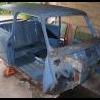Right. I have been back from university for a few days and so have manage to finish off my engine crane.
Since my last post I have finish making all the 24mm diameter holes needed, welded the pivot to the bottom of the bottle jack, made the pivot for the top of the bottle jack out of two plates and a piece of roll cage tubing, welded on the plates for the jib arm to pivot about and made a handle for the bottle jack.
Here are the photos and a video showing it working. I have used it to lift my engine up with the arm at full reach and it works

.

Main pivot arm plates welded in position

Bottle jack in position

Engine about an inch off the floor

Video of it working (apologies the video is a bit dark)
A few things to note.
The crane will lift about 180 kg at it's furthest reach. This may seem a bit low but that is because the bottle jack I used is not a particularly strong one. My engine and gearbox only weigh 160 kg so It will be able to lift it. If I shorten the jib arm then it will lift more so there is no problem.
The starting height of the jib arm can be adjusted as the bottle jack also has part that screws in and out to adjust its starting height.
Ideally you need two people to assemble it. It is a bit difficult to hold everything together and get the bolts in. The crane can be disassemble into 6 parts that can be stood up against a wall to keep it out the way. I have narrow the track on mine so it will fit between mini front wheels.
As said at the end of my video. If I had the option of building one instead of buying I wouldn't bother. It took way too long to produce mainly because it is difficult to make 24 mm holes. The amount of cutting fluid used was ridiculous for such a crude piece of engineering. I have saved about £70 compared to buying one that can lift the same amount (approximately 1/2 ton) which would still have to be assembled. It is a good project if you have most of the materials available (I had most of the hardware needed and steel plate) especially If you want to test out your welding skills before attempting body work (lot harder to burn through 1/4" steel plate compared to 18 gauge sheet steel). Still it is something I can claim I have done and may be useful when applying for engineering jobs and my MSC.
Now its finished I can resume work on the actual car.
























